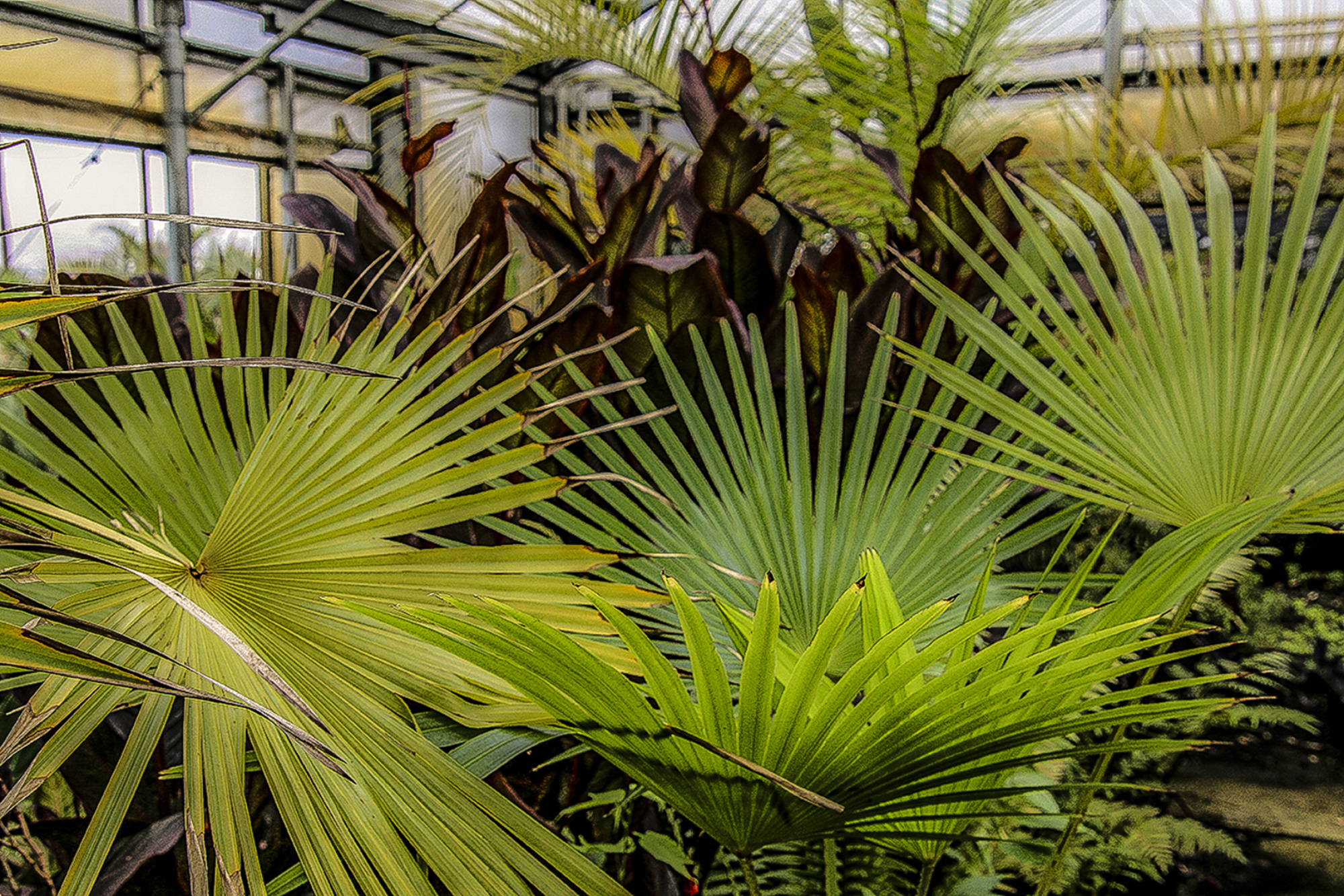
Hippeastrum


Your Northwest source for hardy palms, tropical and tropical-looking plants





Potinara, like Cattleyas, I feel pretty comfortable with. They are not very fussy. They are not urgent for water and they bloom easily and fairly frequently – two or three times a year. They come from four related families of orchids: Brassavola, Cattleya, Laelia, and Sophronitis.
In general, I feed the orchids three out of four waterings. I use a liquid fertilizer, balanced, at one-quarter strength. The fourth watering is to flush out any accumulated salts.

For years I have not known what this plant was. It appears like a weed in pots in the greenhouse, amongst the palms, colocasias, bananas, cycads. Many times I pulled it out and when I did so, I noticed there were no roots. Well, lo’ and behold, one day a visitor comes by and says, “Psilotum nutum”.
I look at him funny and say “same to you.” He says, “No, you have it. It’s a primitive fern, very difficult to find. After he points it out and I see what he is talking about, I’m overjoyed. It isn’t a weed, but more ancient than leaves, flowers and seeds. Like cycads, Psilotum nutum was in existence when dinosauers walked the earth.
Apparently it can be found in Florida and parts of Texas, requiring tropical or sub-tropical conditions. However, I have found it in palm pots out in the yard that were subject to temperatures in the 30’s. Never have I seen it in the ground. Here in the greenhouse, it is always with another plant, so I wonder if isn’t symbiotic in nature. According to biologists it has the xylem for water transport, but no phloem for sugar transport. The stems are triangular and at times sport small yellow heads, which must be spores vessels.

Friends, besides the good-old dependable Windmill Fan Palm or Chinese Fan Palm (Trachycarpus fortunei), there IS another palm just as hardy for the PNW. It is a close cousin called Trachycarpus wagnerianus, or “Waggie” for short (by the way, trachycarpus means “hairy body” or hairy trunk in our case).
Waggies have smaller, tighter, stiffer palms than fortunei. The crown as a whole isn’t as wide, and some people think the overall look is more elegant and handsome. You should decide for yourself. While somewhat slower in growth, it will have no problem reaching a height of 30′ or 40′ or more, just like its cousin. And, most important, they are just as hardy.
It is the exciting to know there are more choices! And here at Raintree Tropical we’re excited to be raising waggies from our own seed. Our first generation, germinated in 2013, is now at 5 and 7 gallon size, 2 – 3′ in size. We also have some planted in the ground in our fields (and they are alittle bigger).

Our white ornamental gingers, Hedychium coccineum, are blooming at last. Here it is October! Better late than never, as they say. And the fragrance is so wonderful, right there with any jasmine and gardenia. This ginger is hardy to the PNW, asking only for a bit of mulch to protect the surface running rhisome. Place it close to a south facing wall if you have one and the collected heat will help in all respects. Many love the foliage, which is arrow-like on stalks that can reach 4′. The emerging stalks in May look like bamboo shoots.
There are many different ornamental gingers. We have five or six and the colors include orange, pink, and yellow. Some have variegation in the leaves and some are bronze colored on the underside. Be sure to explore these wonderful plants if you are not familiar with them.

The growing season is coming to an end. With the temperatures chilling be sure to protect your Alocasias and Colocasias. Most likely, you’ll want to bring them inside to a well-lit area that will stay above freezing. And, you will cut back on watering to prevent rot.
If you have good south-facing light and heat above 50, you can skip dormancy and continue to grow and enjoy your Taro-esque plants. But don’t freak-out if you don’t or can’t. Just allow them to go dormant. Cut back the failing leaves and stems, and, like I said, reduce the watering to a minimum and set them aside in a safe place/labeled so you don’t forget who they are.
Here at Raintree, most of our elephant ears are kept in the cooler greenhouse which heats at 40, and it is not enough to keep them growing. Instead they go slowly into dormancy and disappear into their pots. In December and January I like to divide them and replenish their soil in preparation for the new growing season. And it isn’t until June and July before they are looking good and full. Ok, later, we can talk more about division.

This is the cycad Macrozamia reidlei. Cycads are cool because they are the primitive palms. They were around when Dinosaurs dominated the planet. They are rare to see in the PNW. The one most people are familiar with is the sago palm, Cycas revoluta, but there are many more, diverse and beautiful, as only a cycads can be.
Macrozamia reidlei is big and brawny, but doesn’t like freezing wet weather. It goes inside for the winter. It is found in western Australia, with winter lows at 40 degrees.
They need good drainage and have compact root systems that don’t mind confinement in a small pot. To swallow them in a big pot with a heavy peat potting mix is certain to induce root rot. Like all cycads they are slow growing and one flush of a rosette of new leaves a year is good for our region. Good light with alittle afternoon shade (in August) makes them happy. And don’t forget to feed it now and then.